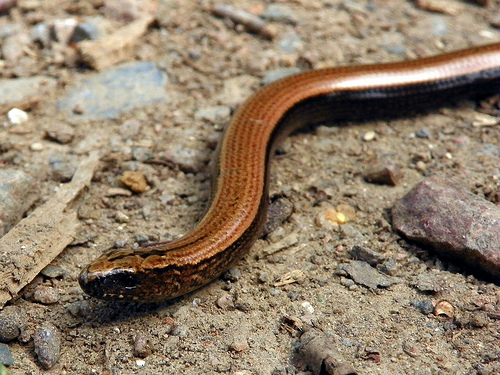Do not be fooled! Slow worms are not worms or snakes!
- Slow worms are lizards, found across Europe and Asia, that do not have legs, and move using body muscles.
- ‘Slow worms’ are also known as ‘slowworms’, ‘blindworms’ and ‘blind worms’, while the scientific name is Anguis fragilis, from the family Anguidae, a family of lizards.
- Slow worms are commonly found in urban gardens, as well as grass plains and farming areas, where areas are damp and warm, and they are often hidden under objects.
- The length of a slow worm typically reaches 20 to 50 centimetres (8 to 20 inches) in length and it can weigh 20 to 100 grams (0.7 to 3.5 ounces).
- The colour of slow worms is generally a combination of black, grey, brown, tan and yellow, while males are occasionally spotted blue.
Slow Worm
Image courtesy of Peter O’Conner/Flickr
- Despite similar appearances, a slow worm can be distinguished from a snake, as the lizard has blinking eyelids; ears that are typical of a lizard; and it discards only portions of its skin at one time.
- The diet of slow worms consists primarily of insects, worms, spiders, snails and slugs.
- A slow worm can break off its tail to escape predators like birds, that will regrow to a shorter length, although this escape method is not always effective against other predators such as cats and dogs.
- Female slow worms produce an average of around 8 young at a time, and the babies form inside eggs in the mother’s body, although they are born live (the process known as ovoviviparity).
- Slow worms can move at speeds of up to 0.5 kilometres per hour (0.3 miles per hour), and have an average lifespan of 10 to 30 years.
Bibliography:
Angius fragilis, 2015, Wikipedia, http://en.wikipedia.org/wiki/Anguis_fragilis
Slow Worm, 2013, A-Z Aniamls, http://a-z-animals.com/animals/slow-worm/
Slow Worm, n.d, RSPB, http://www.rspb.org.uk/makeahomeforwildlife/wildlifegarden/atoz/s/slowworm.aspx







